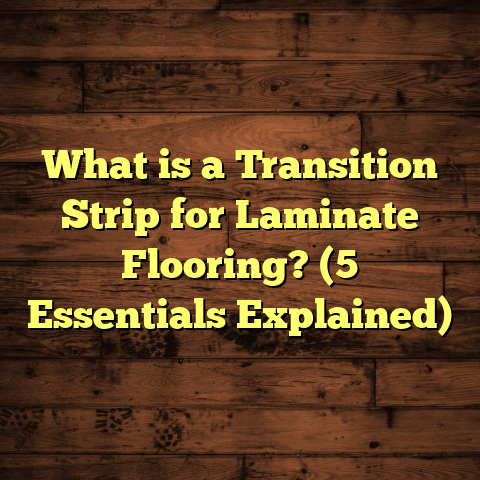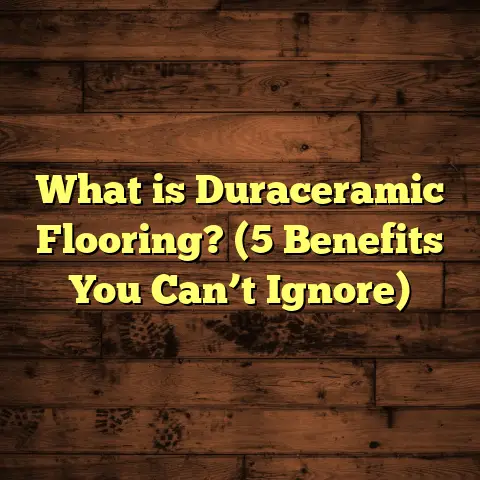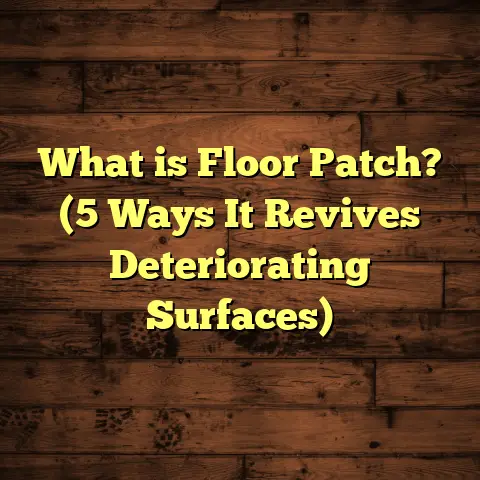What is a Reducer for Flooring? (5 Key Benefits Explained!)
Some things in home improvement might seem small
but turn out to be game changers. Like the tiny piece
that sits quietly between two different types of flooring,
making everything look seamless and professional.
Ever wondered what that little strip is called?
It’s a reducer. I’ve worked with many flooring projects
over the years, and I can tell you—reducers aren’t just
about looks. They bring real function and value to a job.
If you’re new to flooring or even if you’ve had some experience,
you might have seen these strips but never really thought much about
why they’re there or what makes them so important. Well, pull up a chair,
because I’m going to walk you through everything you need to know
about reducers for flooring—from what they are to why I insist on using them,
to how they can save you money and headaches.
What is a Reducer for Flooring?
A reducer is a specially designed molding piece
that helps connect two floors that are different heights.
Imagine you have hardwood flooring that’s 3/4 inch thick in your living room,
and right next to it, your kitchen has vinyl planks that are just 1/4 inch thick.
Without some kind of transition piece, you’d have a noticeable step down.
That’s where a reducer comes in. It gently slopes from the higher floor down
to the lower one, creating a smooth transition that looks good and is safe to walk on.
Reducers typically have these features:
- They are about 3/4 inch thick at the highest point (where the thicker floor is)
- Taper down smoothly to zero thickness (where the thinner floor is)
- Come in lengths usually around 78 inches (6.5 feet), enough for standard doorways or hallways
- Made from materials matching or complementing the floors—wood, laminate, vinyl, or metal
The design is simple yet clever because it hides the height difference and protects the edges of your flooring material.
I’ll admit, when I first started installing flooring many years ago, I didn’t pay much attention to reducers. But after a few jobs where clients complained about tripping or chipped edges, I learned fast that these little moldings are worth their weight in gold.
A Closer Look: Types of Reducers
You might be surprised by how many types of reducers there are. Here are the main ones I use regularly:
- Wood Reducers: Made from solid wood or engineered wood, perfect when transitioning between hardwood and thinner materials like vinyl or laminate. They can be stained or finished to match floors exactly.
- Laminate Reducers: Specifically designed for laminate floors; often made from composite materials with laminate veneer on top.
- Vinyl Reducers: Usually flexible strips that can adapt to slight variations in floor height, ideal for vinyl plank or sheet vinyl floors.
- Metal Reducers: Less common but used in commercial settings or modern designs where durability is a priority.
Each type has its own installation method and price range, which we’ll get into later.
Why Do You Need a Reducer? 5 Key Benefits Explained
I’m often asked why reducers are necessary. Can’t you just leave the floors as they are or use some other molding? Sure, but reducers solve specific problems very well. Let’s break down the top five reasons I always recommend installing reducers where floors differ in height.
1. Safety First: Reducing Trip Hazards
Have you ever tripped over a sudden step-down between rooms? It’s annoying at best, dangerous at worst—especially for kids or elderly relatives.
A reducer takes that abrupt change and softens it into a gentle slope that’s much easier to walk across without stumbling.
In one of my recent projects, an older couple was worried about their transition from carpeted hallway to tile in the kitchen because of falls in the past. Installing a reducer made the whole path safer and gave them peace of mind.
According to the U.S. Centers for Disease Control and Prevention (CDC), falls are the leading cause of injury among adults over 65 years old in the U.S., accounting for over 3 million emergency room visits annually. Many of these accidents happen due to uneven floor surfaces. A simple reducer can help reduce this risk significantly.
2. Protecting Flooring Edges from Damage
Edges of flooring materials like hardwood or laminate take a lot of abuse from foot traffic and furniture movement. Without protection, these edges chip, splinter, or crack quickly.
Reducers act like armor for these vulnerable edges by covering and supporting them where floors meet lower surfaces or doorways.
I have clients who tried to save money by skipping reducers only to call me back within a year asking for repairs on damaged edges—repairs that cost more than just installing reducers upfront.
3. Creating a Professional and Finished Look
When I walk into homes with freshly installed floors but no proper transitions, it always feels incomplete to me—like wearing nice shoes with holes in them.
A reducer tidies up those gaps and differences in heights so your floors look intentional and professionally installed.
Sometimes I think people underestimate how much these small details impact overall design. In fact, when I include reducers in my projects, clients often comment on how much “nicer” their floors look once everything connects smoothly.
4. Accommodating Different Flooring Materials Easily
Mixing flooring types is practical and stylish—tile in wet areas, hardwood in living spaces, carpet in bedrooms—but these materials rarely have matching thicknesses.
Reducers handle those differences beautifully without awkward steps or gaps.
For example:
- Hardwood planks typically measure 3/4 inch thick (19mm)
- Luxury vinyl planks range from 2mm to 8mm thick
- Ceramic tile usually sits around 1/2 inch thick (12mm)
A reducer bridges those differences with a smooth slope instead of a sharp step.
5. Cost-Effective and Time-Saving Installation
I get it—adding extra pieces means more cost and time right? Not really.
Reducers generally cost between $15 to $50 per length depending on material quality and finish. Installation takes about 30 minutes per doorway or transition spot for a professional like me.
Compared to potential repair costs from damaged edges or injuries from tripping, reducers pay off quickly.
To keep my estimates accurate and save time when planning projects, I use tools like FloorTally. It pulls local material prices and labor costs into one place so I don’t waste hours chasing quotes.
How Do You Choose the Right Reducer?
Choosing the correct reducer involves matching three main factors:
Height Difference Between Floors
Measure the thickness of both floors right where they meet.
If your hardwood is 3/4 inch thick and vinyl is 1/4 inch thick, you want a reducer that slopes from 3/4 inch down to zero smoothly.
Width of Transition Area
Standard reducer widths range between 1 1/2 inches up to 2 1/2 inches depending onYour request failed. Please try again.





